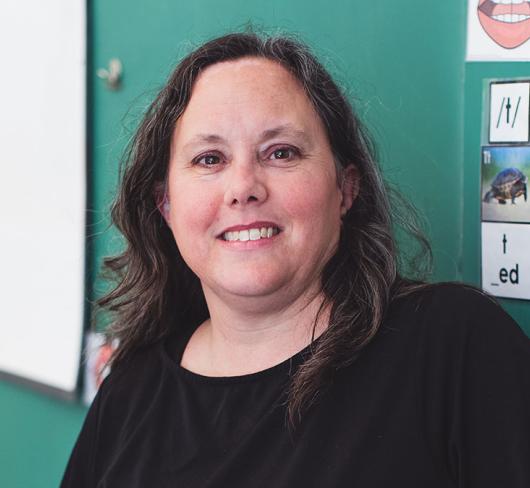
Spelling: Connecting the Pieces
In Voice (Winter 2004,) I outlined major research findings on the teaching of spelling. These studies emphasize that, while children seem to follow a stagelike process in learning to spell, they nevertheless need systematic instruction in spelling throughout the elementary grades. This formal instruction must then be linked with everyday writing for meaningful transfer to take place.
Mature spellers have a working knowledge of the patterns that underlie the English spelling system in the areas of sound, structure and meaning. They also have a repertoire of spelling strategies to use in recalling words that are irregular.
How can teachers provide the necessary support for all students so that they can experience success as spellers? The following suggestions provide a framework that you can adapt to your grade and classroom.
Spelling Patterns
Although there are exceptions to almost every rule in written English, it is still important to help children understand the major patterns in the language. Knowing these generalizations helps students move away from a memorization approach to one that focuses on making sense of the language. These patterns exist at every level of English. A partial list is found on the next page.
| Sound Patterns | Structural Patterns | Meaning Patterns |
|---|---|---|
|
vowel patterns
consonant patterns
|
syllables stress patterns adding endings to base words: plurals, -ed and -ing, suffixes changes to base words when endings added:
contractions possessives hyphens |
compound words base and root words past tense markers (-ed) plural markers homophones prefixes and suffixes |
Teachers have to decide, of course, which patterns to address in a specific grade. Even within a grade, the answers will vary depending on the backgrounds of the students. One approach is to be aware of the developmental spelling levels of students in your class and to link spelling concepts with these stages. Published material is available that describes the developmental continuum for spelling and provides helpful information for assessing students. Typically, however, the stages are not linked to grades, and the advice about which concepts to teach at each grade is fairly general. This approach is perhaps best suited to small classes where teachers can assess each child's development and individualize the spelling program.
A reputable published program of spelling texts based on the developmental continuum for learning to spell can address many of the concerns above. Whether teachers consult the scope and sequence as a reference or use the actual program, these texts are usually linked closely with provincial curriculum documents and with typical benchmarks for students at a given grade. The program selected must be flexible to allow for the many levels of ability in a class, and should invite students to add their own words to the word list.
In addition to this formal approach to studying spelling patterns, it is vital to address patterns throughout the school curriculum. These opportunities help to reinforce and consolidate learning that may have been introduced in a more structured manner. An inquiry approach, which encourages students to spot patterns rather than memorize rules, is most effective. You can use word sorts and Venn diagrams to help your students see these generalizations.
For example, as part of a grade 3 social studies unit on urban and rural communities, have students sort the words below into two categories: short and long vowels.
- lakes
- crosswalk
- signs
- streets
- water
- pond
- roads
- homes
- village
- land
To make the activity more challenging, add new words to the mix and ask students to arrange the set on a Venn diagram. The new words energy, city, and arena would be placed in the overlapping parts of the intersecting circles since they contain both long and short vowels. Your students could then find other words related to communities and categorize them in the same way.
Word building becomes important skill as students encounter longer words in their reading and try to use them in their writing. Demonstrate how long words often result from a prefix and/or suffix being added to a base or root word. For example, multinational can be shown as multi + nation + al. It also helps to colour-code the parts of a word so that the prefix, base word and suffix are each in a different colour. an increasingly its encounter their reading and in their writing.
Word webs also help students to see how words are connected through common bases. The web below is built from the base word heal and could be explored in the Healthy Living component of the Health and Physical Education curriculum.
Children in the primary grades may be able to supply only a few extensions foi heal, while intermediate students will likely be aware of many more. If some of your students are unfamiliar with the word healthful and its derivatives, this would be a good chance to check the meaning in a dictionary.
Spelling Strategies
Mature spellers not only understand the basic patterns underlying written English; they also are aware that many English words have irregular spellings. These tricky words include short highfrequency words such as said, long words borrowed from other languages such as cappuccino, and schwa vowels in unstressed syllables, as in "strategy ."
Skilled spellers have a tool kit of spelling strategies that they use to recall these challenging words. To a certain degree, the use of strategies follows a developmental curve, with sound-based strategies being most prevalent in the early grades, but research has shown that even young children use a mixture of strategies when learning to spell.
Teachers can help children broaden the range of strategies they use, since poor spellers tend to have a very small repertoire of spelling strategies. It is also important to help children realize which strategies work best for specific words. For example, a sounding-out approach to words with silent letters, such as knight, would be ineffective, but this strategy does work well for many other words. When all else fails, we need to resort to mnemonics, or memory tricks. A familiar example of a mnemonic is to remember the double s in dessert by saying "I like seconds for dessert" or "I love strawberry shortcake for dessert."
Spelling strategies work best when students are involved in reflecting on their own processes. Model the spelling strategies when teaching a difficult word. Have the class suggest strategies for spelling tricky words.
The mnemonics they choose may not be yours, but they will be remembered and used more readily than if you present just a list of spelling strategies as in the chart. This list can be a useful reference for you and your students, but it can only be brought to life through application in everyday spelling challenges. Once your students are familiar with these strategies and others, they can place the list in their writing portfolios and refer to it during proofreading conferences or while editing their own work.
A more thorough explanation of these spelling strategies is found in Spelling: Connecting the Pieces (McQuirter and Siamon. 2004).
Spelling and Writing
The study of spelling patterns and strategies will remain just an abstract activity unless students see how this knowledge will improve their writing. A spelling conscience develops when students care about communicating their thoughts on paper and realize that correct spelling is a courtesy to the reader. A rich writing program that engages students personally is a crucial link between the formal study of spelling and its transference to everyday writing.
Nearly 20 years ago, Marjorie Frank wrote, "Good writing is based on a healthy friendship between imagination and technique. It can and must be taught without slighting either." This advice is as relevant today as it was in 1979. Effective teachers know how to balance the formal study of important concepts with reinforcement throughout the day. They know how to connect the pieces.
Ruth McQuirter Scott is an associate professor in the Faculty of Education, Brock University She is the co-author of Spelling: Connecting the Pieces (2004), Gage/Nelson.
Resources
Cramer, R. 1998. The Spelling Connection: Integrating Reading, Writing, and Spelling Instruction. New York: The Guilford Press.
McQuirter Scott, R. & Siamon, S. 2004. Spelling: Connecting the Pieces. Toronto: Gage Learning.
Rees, D. 1997. First Steps: Spelling Developmental Continuum. Portsmouth: Heinemann.
Templeton, S. & Morris, D. 1999. Questions Teachers Ask About Spelling. Reading Research Quarterly, January/February/March, 102-112.

